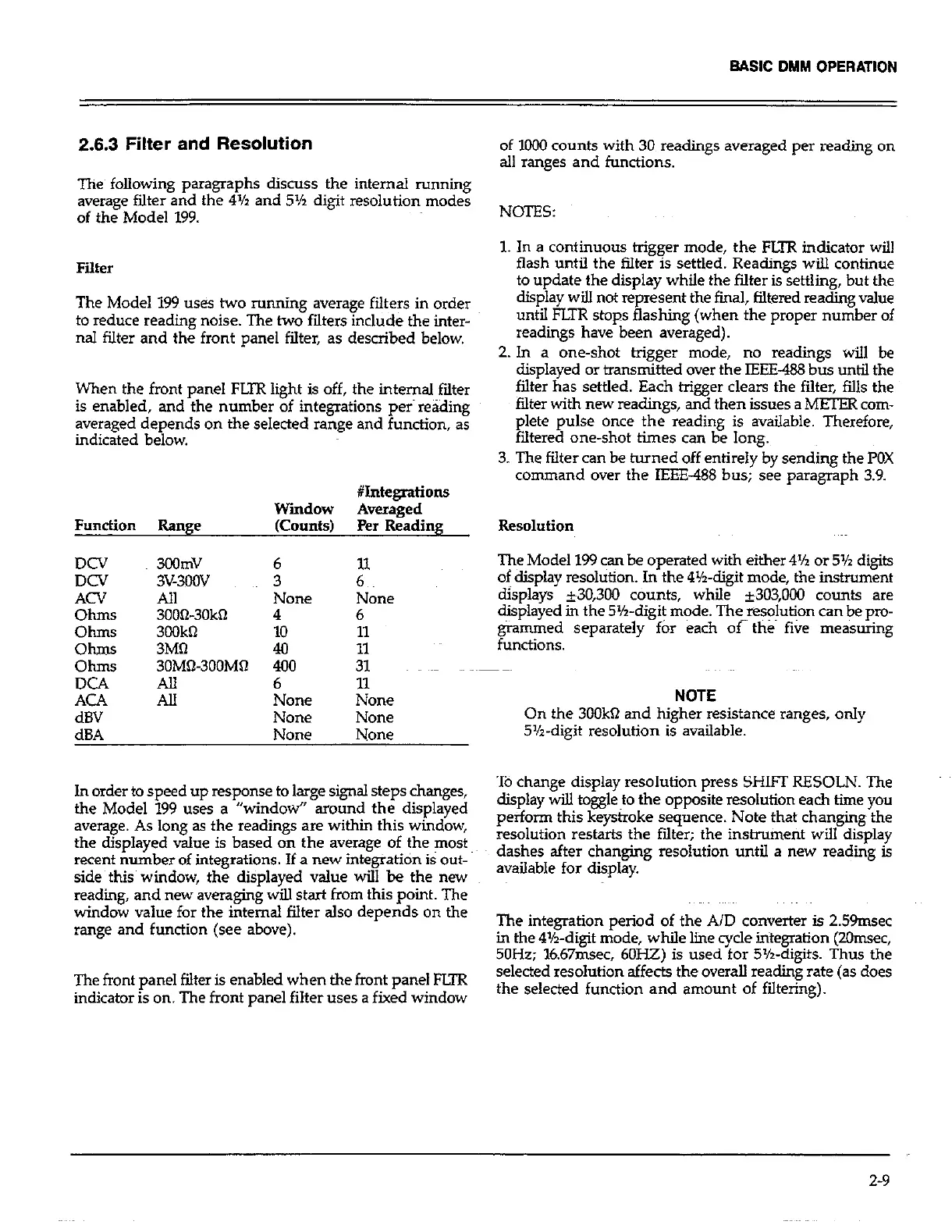2.6.3 Filter and Resolution
The following paragraphs discuss the internal running
average filter and the 4% and 5% digit resolution modes
of the Model 199.
Filter
The Model 199 uses two running average filters in order
to reduce reading noise. The two filters include the inter-
nal filter and the front panel filter, as described below.
When the front panel FLTR light is off, the internal filter
is enabled, and the number of integrations Peru reading
averaged depends on the selected range and function, as
indicated below.
#Integrations
Window
Averaged
Function Range @3me.s) Per Reading
DCV 3OOmv 6
DCV 3V-3OCv 3 i?
ACV All N0P.e None
Ohms 300%30kQ 4 6
Ohms 3OOkQ 11
Ohms
3MR ii
Ohms
30MQ-300MQ 400 ;
DCA
All 6
11
ACA
All NOIW None
dBV
NlXE None
dBA None None
In order to speed up response to large signal steps change,
the Model 199 uses a “window” around the displayed
average. As long as the readings are within this window,
the displayed value is based on the average of the most
recent number of integrations. If a new integratidn is out-
side this window, the displayed value will be the new
reading, and new averaging will start from this point. The
window value for the internal filter also depends on the
range and function (see above).
The front panel filter is enabled when the front panel FUR
indicator is on. The front panel filter uses a fixed window
of 1000 counts with 30 readings averaged per reading on
all ranges and functions.
NOTES:
1. In a continuous trigger mode, the FLTR indicator will
flash until the filter is settled. Readings will continue
to update the display while the falter is settling, but the
display will not represent the final, filtered reading value
until FLTR stops flashing (when the proper number of
readings have been averaged).
2. In a one-shot trigger mode, no readings will be
displayed or transmitted over the IEEE-488 bus until the
filter has settled. Each trigger clears the filter, fills the
filter with new readings, and then issues a METER corn-
plete pulse once the reading is available. Therefore,
ftitered one-shot times can be long.
3. The filter can be turned off entirely by sending the POX
command over the IEEE-488 bus; see paragraph 3.9.
&WllUtiOIl
T+ Model 199 can be operated with either 4% or 5% digits
of display resolution. In the 4?&digit mode, the instrument
displays &30,300 counts, while +303,OOO counts are
displayed in the 5%digit mode. Tlw~@ution can be pro-
g&nmed separately for each of the five measuring
functions.
NOTE
On the 3OOkQ and higher resistance ranges, only
5%digit resolution is available.
To change display resolution press SHIFT RESOLN. The
display will toggleto the opposite resolution each time you
perform this keystroke sequence. Note that changing the
resolution restarts the ffiter; the instrumetit will display
dashes after changing resolution until a new reading is
available for display.
The integration period of the AID converter is 2.591~~
in the 4%-d@ mode, while line cycle integration (2Omsec,
50Hz; 16.671&c, 60H.Z) is used ! for 5%digits. Thus the
selected resolution affects the overall reading rate (as does
the selected function and amount of filtering).
2-9
